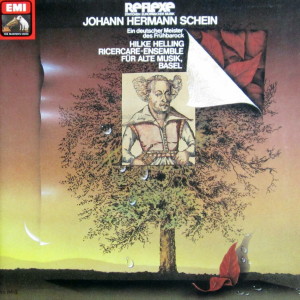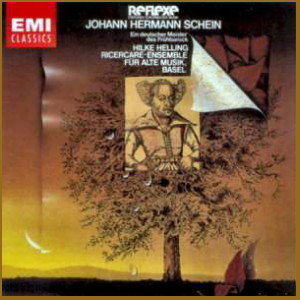 |
1 LP -
1C 069-46 405 - (p) 1982
|

|
| 1 CD - 8
26527 2 - (c) 2000 |
|
| JOHANN
HERMANN SCHEIN (1586-1630) - Ein
Deutscher Meister des Frühbarock |
|
|
|
|
|
| Intrada a 5 -
4 Schalmeien, Dulzian |
2' 05" |
|
| Intrada a 5 -
4 Schalmeien, Dulzian |
1' 27" |
|
| Galliarda a 5
- 2 Schalmeien, Altpommer,
Tenorpommer, Baßdulzian |
0' 51" |
|
| Christ, unser
Herr, zum Jordan kam
(Geistliches Konzert a 5 und Bc.) -
Mezzosopran, Blockflöte,
Altdulzian, Tenordulzian, Laute |
4' 23" |
|
| Canzon
a 6 - 2 Tenorblockflöten,
Baßblockflöte, 2
Großbaßblockflöten,
Kontrabaßblockflöte |
4' 48" |
|
| Lobert
den Hern in seinem Heiligtum
(Motette a 5) - 4 Schalmeien,
Dulzian |
2' 43" |
|
| Canzon a 5 -
2 Sopranblockflöten, Altdulzian,
Tenordulzian, Baßdulzian |
3' 52" |
|
|
|
|
| Padouana a 4
- 4 Krummhörner |
2' 03" |
|
| Suite Nr. 15 aus
"Banchetto musicale", Leipzig 1617
- Sopranblockflöte,
Altblockflöte, 2 Tenorblockflöten,
Baßblockflöten |
|
|
| -
Padouana · Gagliarda · Courante ·
Allemande · Tripla |
5' 32" |
|
| Drei Lieder aus
"Musica boscareccia oder
Wald-Liederlein" - Mezzosoprano,
Blockflöte, Viola da gamba,
Theorbe |
|
|
| -
O Fili, wärt Ihr mein |
3' 32" |
|
| -
O Scheiden, o bitter Scheiden |
2' 43" |
|
| -
O Schäferin, o Filli mein! |
2' 42" |
|
| Suite
Nr. 6 aus "Banchetto musicale",
Leipzig 1617 - 2
Tenorblockflöten, Baßblockflöte,
Altdulzian, Baßdulzian |
|
|
| -
Padouana · Galliarda · Courante ·
Allemande · Tripla |
7' 23" |
|
|
|
|
| RICERCARE-ENSEMBLE
FÜR ALTE MUSIK, BASEL |
|
| -
Gabriel Garrido, Michel Piguet,
Sabine Weill, Marilyn Boenau,
Randall Cook, Catherine Duval |
|
| unter
Mitwirkung von: |
|
| -
Hilke Helling, Mezzosopran |
|
| -
Anthony Bailes, Laute
(Malcom Prior, London 1979) und
Theorbe (Jacop van de Geest, Vevye
1973) |
|
| -
Pere Ros, Viola da gamba
(BaßGambe von Emil Misek, 1979,
nach Antonio Siciliano, Zeit
unbekannt, Nationalmuseum Wien) |
|
|
|
|
|
Luogo
e data di registrazione |
|
Evangelische
Kirche, Séon (Svizzera) - 18-20
gennaio 1979 |
|
|
Registrazione: live /
studio |
|
studio |
|
|
Producer / Engineer |
|
Gerd
Berg / Klaus L. Neumann /
Johann-Nikolaus Matthes
|
|
|
Prima Edizione LP |
|
EMI
Electrola "Reflexe" - 1C 069-46
405 - (1 lp) - durata 45' 00" -
(p) 1982 - Analogico |
|
|
Prima Edizione CD |
|
EMI
"Classics" - 8 26527 2 - (1 cd) -
durata 45' 00" - (c) 2000 - ADD |
|
|
Note |
|
Aufgenommen
in Zusammenarbeit mit WDR.
|
|
|
|
|
|
Even today,
some people still include
Johann Hermann Schein among
the minor masters of the
Baroque, which is without
doubt a false evalutation.
This mis-judgement cannot be
blamed on musicologists, yet
Schein, Kantor of the
Thomaskirche in Leipzig
1616-1630, continues to
maintain but a pallid
existence in our modern,
practical musical awareness,
as indeed does his friend and
contemporary, the Sweelinck
pupil Samuel Scheidt
(1587-1654) from Halle
-together with Heinrich Schütz,
Scheidt and Schein made up the
"three famous S’s" of
the 17th century (W. C.
Printz, Historische
Beschreibung der Sing-
und Klingkunst,
“Historical description of
vocal and instrumental art”,
1690). Students of music
always had to learn ’the three
great S’s’ parrot fashion, put
investigation of Schein and
Scheidt rarely went
much deeper. In the
wake of the Bach Renaissance,
Schein vvas respectfully
mentioned from time to time as
an important ’predecessor‘ of
Bach’s, as the composer who ’blended‘
the traditional late
Netherlandish-German stylistic
heritage with the Italian
achievements of the stile
nuovo. Among some
postwar precentors, who found
Bach too superficial for their
simple, strict ecclesiastical
pretensions (after the total
renunciation of Romanticism),
Schein enjoyed an austere
revival: it is pleasing to
find many of his canzonas and
intradas in the music volumes
of amateur groups and church
brass choruses, and many a
keen music teacher includes
one or another of the fresh-sounding
Wald Liederlein in his
choral repertoire. But that of
course remains rather
piecemeal. Likevise,
the selection on this record
can only hint at the diversity
and the intellectual depth and
purity of Schein’s œuvre;
but it
is perhaps extensive enough to
whet
one’s appetite and convey some
idea of
this singular and important
composer on the threshold of
the German Baroque.
Johann Hermann Schein was born
the son of
a parish priest in Grünhain
nearAnnaberg, in the
Erzgebirge region of
Saxony, on 20th January 1586.
He enjoyed a well-founded
humanist education, first
as a choirboy
ot the Hofkapelle,
the court chapel, in Dresden
(from 1599), then as,
the holder of
a scholarship awarded by
Elector Christian the Second
at the electoral Landeschule
in Pforta
(from 1603), and finally as a
student at the University of
Leipzig (frorn1608),where
he studied
“the fine arts and also
jurisprudence".
After the completion of his
studies in 1612, Schein spent
two
years as ,"preceptor
to their young lordships
and director
of house music" at
Schloß Weißenfels
before travelling to Weimar
to take up the post of Hofkapellmeister
to Duke Johann Ernst the
Younger. Not
long after, however, on 19th
August 1616, he was
appointed to the coveted post
of Thomaskantor,
which had lain vacant since
the death of Calvisius in the
previous year. A degree of
shock is - particularly for
the modern reader - the only
possible reaction to the
details of his and his
families’ lives. Schein
himself, who was
married twice, suffered early
on from various illnesses,
from “gout and kidney stones”
as well
as consumption, of which he
eventually died before
reaching the age of 45. His
friend Heinrich Schütz,
who visited the dying Schein,
wrote the six-part parentation
motet Das ist ja
gewisslich wahr in
accordance with
Schein’s express wish.
The funeral sermon, which was
later printed, was read before
a large group of mourners, and
has presen/ed an abundance of
biographical information for
posterity.
After the Venus Kräntzlein
(Wittenberg 1609) there
appeared at regular intervals
- alongside a large number of
occasional compositions
written for the most part in
Leipzig - a magnificent series
of collections of works both
secular and sacred. Thus Cyrmbalum
Sionium sice Cantiones
sacrae (Leipzig 1605), Banchetto
Musicale (Leipzig 1617),
Opella nova
(1617/1626), Musica
boscareccia, Wald Liederlein
(1621/1626/1628) and its
sacred parody Musica
boscareccia Sacra
(1644/1651) with
sacred texts by E. Leichner, Fontana
d'Israel, Israels Brünnlein (1623),
Diletti pastorali,
Hirtenlust (1624), Studenten-Schmauß
(1626), Cantional oder
Gesangbuch Augsburgischer
Confession (1627).
Schein’s equal propensity
towards “Christian devotion in
church services and to
amusement and diversion at
honest meetings of friends”
represents a synthesis of life and
work, of deep
piety sociable worldliness,
a joje
de vivre
whose sanguine warmth is
irresistible. The Ricercare
Ensemble, following
Schein’s own suggestion and
early 17th century practice,
performed the vocal and
instrumental pieces recorded
here “on all kinds of
instruments” - some pieces are
played by a single family
of
instruments (recorders,
shawms, crumhorns), while
others are performed with
mixed scoring. The listener’s
ear is particularly struck by
the close relationship with
the registers of the
Renaissance organ. Schein’s
suites, all of which have the
movements Padouana - Gagliarda
- Courante - Allemande (with
Tripla), are socalled
variation suites - in other words,
they are written in one key,
and medify
uniform thematic material to
suit the character of the
individual dance movements.
This attempt to link the
individual movements more
closely by the use of
variation elements - a
technique that also features
in the works of Thesselius and
Peuerl - was not pursued by
later composers.
Just as Schein the composer
knew how to combine
imitative-polyphonic
principles splendidly with
homophonic
and concertante
elements, so Schein the poet
created a genial synthesis of
Italian Renaissance poetry and
the sound and emotional
strength of the German folk
song. Schein absorbed
everything new (i.e. Italian)
that his era had to offer with
great sensitivity, but never
renouced his native tradition.
His
composition is always marked
by artistry and informal
logic, yet free of any
unwieldiness. His handling of
texts is often passionate and
florid,
yet always contained within a
supremely controlled form. A
German master of the early
Baroque, in other words, well
worth remembering.
Gerd
Berg, 1982
Translation:
Clive R. Williams
|
|
|
EMI Electrola
"Reflexe"
|
|
|
|

